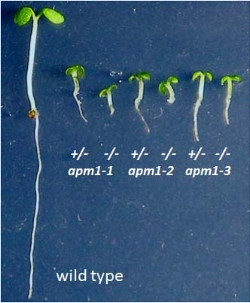Seedling Establishment
5-d old wild type and apm1 Arabidopsis seedlings. From Peer et al., 2009 Plant Cell
Seedling establishment is the critical stage in plant growth and development when
1) The root must penetrate into the soil so that it can successfully acquire water and nutrients.
2) The shoot must elongate and leaves must expand to begin photosynthetic activity.
3) The discontinuous embryonic vasculature must mature to accommodate transport of water, nutrients and photosynthate.
If these objectives are not achieved before reserves in seeds and seed leaves are exhausted, the plant dies.
Integration of signals
Seedling establishment is an integration of gravitropic, hydrotropic, chemotropic, thigmotropic, and phototropic signals, and responses to pathogens and herbivores.
Phototropism: Seedlings bending toward unidirectional blue light. From Zhang et al., 2016 PNAS. Special thanks to Candace Pritchard.
Adaptation to environmental change
Adaptive evolution is driven by selective pressure. Selective pressures include climate change, increased ozone levels, and herbicide use. Both native and non-native plants undergo adaptive evolution. Some non-native plants become invasive. Some native plants become herbicide resistant. The successful plant grew from a seedling that established successfully. We want to know "What makes them special that they can adapt so quickly?"
Seedling establishment is an integration of gravitropic, hydrotropic, chemotropic, thigmotropic, and phototropic signals, and responses to pathogens and herbivores. The integration of developmental and environmental signals in 3.5-5 day old seedlings is critical for successful seedling establishment. The goal of the research in my lab is to elucidate the integration of these mechanisms in seedling establishment.

